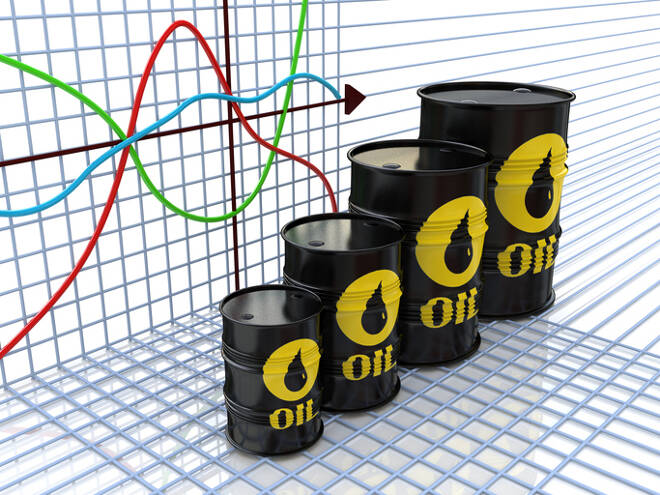Advertisement
Advertisement
With Saudi Arabia Preparing to Slash Shipments to U.S. Refiners, Crude May Be One Big Inventory Draw Away from Sparking Rally
By:
Saudi Arabia’s plan is pretty clear. Their strategy is to cut exports to the United States in order to prevent a build in U.S. crude oil supply. Since they plan to make their move starting in January, this is likely to have a more immediate effect on prices then predictions of lower “future demand”.
It’s been over a week since the OPEC-led group of exporters announced it would trim 1.2 million barrels per day from production starting on January 1. Last week’s consolidation suggests the aggressive selling pressure has subsided, but without a bullish catalyst to shake out some of the weaker short-sellers, the market is going to have a hard time defeating the current bear market.
Although U.S. West Texas Intermediate and international-benchmark Brent crude oil finished lower for the week, February WTI crude oil managed to hold the minor bottom at $50.31, while remaining well-above the main bottom at $49.60. February Brent crude oil held its minor bottom at $58.39 and its main bottom at $57.78.
At the same time, WTI remained well-below its recent minor top at $63.71 and Brent under its last minor top at $63.71.
For the most part, the daily ranges remained tight. However, the widest range occurred on Thursday when the markets recovered from early weakness to post its highest close for the week. Although there was no follow-through to the upside on Friday, I think the price action on Thursday should be looked at more closely because the catalyst behind that move may be what drives prices higher over the near-term.
Prices Fell on Friday on Concerns Over Future Demand
First, let’s look at Friday’s price action. WTI and Brent crude oil futures settled lower on Friday but inside the previous day’s session. Driving the markets lower, or preventing buyers from following-through to the upside were the reports of weaker-than-expected economic data from China and Europe. So basically the selling was fueled by concerns over future demand.
The key phrase here is “future demand”. In other words, the reports didn’t show that crude oil demand had fallen, but based on the numbers, it could fall in the future.
Prices Rose on Thursday on Concerns Over Future Supply
This brings us back to the news from Thursday that drove prices higher. According to Bloomberg, oil prices jumped on December 13 as Saudi Arabia prepared to slash shipments to U.S. refiners in an effort to prevent a price-killing buildup of American stockpiles.
Bloomberg’s report went on to say that the Saudi state-controlled oil company has warned U.S. refiners to brace for a steep drop in cargoes next month, according to people briefed on its plans. Additionally, American refiners have been told to expect lower shipments from Saudi Arabia in January compared with recent months after last week’s OPEC agreement to cut production, according to the people.
Other Potentially Bullish Factors
On Thursday, prices were also supported by a report of a large drop in stockpiles at the U.S. storage hub in Oklahoma, as well as an International Energy Agency (IEA) warning that global supplies may be more fragile than previously thought.
Stockpiles could fall at the storage hub at Cushing, Oklahoma because of lower shipments from Saudi Arabia. Additionally, a report from the IEA said that combined output losses from Iran and Venezuela could reach 900,000 barrels a day during the second quarter of next year, more than doubling the 800,000 barrels OPEC plans to remove from the world markets.
Timing Suggests Bulls Should Win Battle Between Supply and Demand
Saudi Arabia’s plan is pretty clear. Their strategy is to cut exports to the United States in order to prevent a build in U.S. crude oil supply. Since they plan to make their move starting in January, this is likely to have a more immediate effect on prices then predictions of lower “future demand”.
If you’re bullish crude oil then you’re going to have to be patient. It may take a couple of weeks of bigger-than-expected drawdowns in crude oil inventory to spook some of the weaker shorts out of the market.
Furthermore, since the hedge funds are short, all we need to see is a major hedge fund aggressively covering their short positions to fuel the start of a serious rally. This is because of the “Herd Theory”.
Hedge funds don’t like quiet markets. They like volatility. So if we start to see big withdrawals from inventory then this may be the catalyst that starts the next rally.
About the Author
James Hyerczykauthor
James Hyerczyk is a U.S. based seasoned technical analyst and educator with over 40 years of experience in market analysis and trading, specializing in chart patterns and price movement. He is the author of two books on technical analysis and has a background in both futures and stock markets.
Did you find this article useful?
Latest news and analysis
Advertisement
